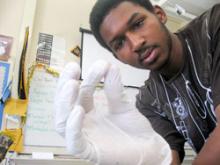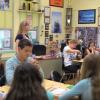The strategies that 12 states used to integrate performance assessment into state systems of assessment.

City Arts and Technology High School case study
Dozier-Libbey Medical High School case study
Impact Academy of Arts and Technology case study
Life Academy of Health and Bioscience case study
While, nationally, students of color and low-income students continue to achieve at far lower levels than their more advantaged peers, some schools are breaking that trend. These case studies look at four such schools in Northern California in which traditionally underserved students are achieving above state and district averages.
The Student-Centered Schools Study — funded by the Nellie Mae Education Foundation — focuses on schools using student-centered practices through either the Linked Learning or Envision Schools model. Linked Learning, a state-wide initiative, integrates rigorous academics with career-based learning and real-world workplace experiences. Envision Schools is a small charter network that creates personalized learning environments for students to develop 21st century skills such as critical thinking, problem solving, and collaboration.
These student-centered environments emphasize supportive relationships between students and teachers in academic environments that are challenging, relevant, collaborative, student-directed, and connected to real-life situations. Students are assessed on their mastery of knowledge and skills and have multiple opportunities to demonstrate that mastery. Educators are supported in creating a student-centered learning environment through opportunities for reflection, collaboration, and leadership. Research shows that this is the type of setting necessary for students to develop the skills to succeed in college, career, and life.
The case studies use quantitative data to track achievement and extensive observations, surveys, and interviews to document practices. In all schools, African American, Latino, economically disadvantaged, and English learner students achieved above — and, in some cases, substantially above — similar students in their districts and in the state.
Student-centered practices are more often found in schools that serve affluent and middle-class students than those located in low-income communities. Creating student-centered learning environments is one way the country can effectively address the opportunity gap for these students.
The teachers . . . try to help you. At other schools [teachers] might not really care if you pass or not. The teachers here, they really want you to succeed in life. They want you to keep trying. They hand out their cell phone numbers in case you need help. They want you to contact them at their email. They really want you to do your work and proceed to a good college and proceed to a good career.
— City Arts and Technology High School student
While, nationally, students of color and low-income students continue to achieve at far lower levels than their more advantaged peers, some schools are breaking that trend. A new set of cases studies looks at four of these schools in Northern California in which traditionally underserved students are achieving above state and district averages.
This report, funded by the Nellie Mae Education Foundation, explores how City Arts and Technology High School (CAT) is using student-centered approaches to learning to ensure that all students, especially those who are underserved, are college-ready upon graduation.
CAT emphasizes a strong student-centered focus, student-based inquiry, self-reflection, student exhibitions and portfolio defenses, and ongoing professional development for teachers. CAT holds students to high academic expectations by nurturing strong relationships with the students and coherent instructional approaches and expectations to help provide consistency for their students, many of whom had not previously experienced academic success.
“Our mission is to transform students’ lives by preparing them for success in college in life…and we believe the core to that is preparing first-generation students, often students of color…for success in college,” says principal Daniel Allen.
“One of the things that the school has always had is a real individualized approach to everything: to discipline, student learning, recruitment. It’s very much student-focused, which is hugely positive.”
— Principal, Daniel Allen
CAT lets the students be themselves, and [because of that] they open up to learning. I think that’s the biggest piece of the puzzle that other schools are missing.
— Parent
"A student-centered school or learning environment [occurs when] the teacher is more of a facilitator in student learning and directs and guides the students into learning through different activities and projects. There’s very little direct instruction. What I do is I give the students information and then try to help them apply it to different situations."
— DLMHS teacher
While, nationally, students of color and low-income students continue to achieve at far lower levels than their more advantaged peers, some schools are breaking that trend. A new set of cases studies looks at four of these schools in Northern California in which traditionally underserved students are achieving above state and district averages.
This report, funded by the Nellie Mae Education Foundation, explores student-centered learning practices at Dozier-Libbey Medical High School (DLMHS) in California—a school serving predominately low-income students and students of color.
Within just five years of opening, the school has achieved at levels far exceeding schools with similar student populations. DLMHS is using student-centered, experiential education to make learning relevant. The school is infusing its health care focus across its curriculum through interdisciplinary, project-based instruction that focuses on student mastery. This means students are engaged and are learning critical work-ready skills like collaboration, critical thinking, and communication.
"Every student valued, every student challenged, every student prepared to succeed in a changing world."
— DLMHS Mission statement
"We know kids learn at different paces, then you have to be flexible about how you assess them and when you assess them.... If you are not ready then why sit there and take a test that you aren’t ready for? Who is going to win? Nobody!"
— DLMHS teacher
Video: Linked Learning and Design Thinking (ConnectEd video). View video (6:20 min)
“Keeping students at the center, both when you’re designing curriculum and when you’re teaching, means incorporating as much student involvement as you possibly can—that’s where the whole project-based learning piece comes in. When students are doing projects that are very hands-on, students are the ones doing the heavy-lifting. Teachers are hands-off, which is a good way for students to learn.”
— Impact Academy of Arts and Technology High School teacher
While, nationally, students of color and low-income students continue to achieve at far lower levels than their more advantaged peers, some schools are breaking that trend. A new set of cases studies looks at four of these schools in Northern California in which traditionally underserved students are achieving above state and district averages.
With more than half of its students living in poverty, Impact Academy of Arts and Technology High School (Impact) is an exemplar of what student-centered teaching and learning looks like in an urban center. This report, funded by the Nellie Mae Education Foundation, explores how student-centered approaches and personalization have fostered a culture of success at Impact Academy.
With a distinct focus on personalization and student engagement, Impact stands out as a unique learning environment when compared to neighboring comprehensive high schools. At Impact, students are expected to know how to synthesize information, determine what’s important, and present what they’ve learned. The school’s assessment model, exhibitions, and defenses become the ultimate measure of whether a student fully understands a concept.
"Students have to care about the topics they’re learning about, so whether that’s identifying with the curriculum from a racial aspect, from a gender aspect, from a class aspect, or from just what they’re interested in today...they’re most engaged when you’re talking about things that relate to their lives, so keeping students at the center when you’re devising and coming up with curriculum is important. “
— Impact teacher
"Our leadership skills operate as the way for kids to reflect on how they go about the work and how it’s contributing to their ongoing re-definition of “who I am as a person and as a student.”
— Jesse Bean, principal
Related resources
A lot of traditional schools are direct instruction in which the student needs to be sitting down silently and recording notes for 40 to 50 to 60 minutes straight, and retain this information and think critically on his or her own without having discussions, and then take a test that’s written or multiple choice questions. I think that’s a very narrow way of accessing student learning and engagement.
— Life Academy of Health and Biosciences math teacher
While, nationally, students of color and low-income students continue to achieve at far lower levels than their more advantaged peers, some schools are breaking that trend. A new set of cases studies, funded by the Nellie Mae Education Foundation, looks at four of these schools in Northern California in which traditionally underserved students are achieving above state and district averages.
This case study looks at Life Academy of Health and Biosciences (Life Academy) in Oakland, California. At Life Academy, student voice and choice drives every decision: what and how to teach, what structure will equip students and teachers to know and believe in each other, and how to bring out the best of the students?
At Life Academy, 99% of the student population is economically disadvantaged—yet students significantly outperform their peers at other district schools. Through the incorporation of student-centered approaches to learning, Life Academy has created structures, rituals and instruction that give students opportunities, voice, and multiple chances at success.
We are going to rally behind intellect and watch our students shine, and we’re going to really champion that. We champion kids and make them feel really successful and they are. They blow us out of the water all the time with what they’re able to do.
— Ninth-grade teacher
Related resources
Oakland Unified School District New Small Schools Initiative. SCOPE report.
Life Academy of Health + Bioscience. Life Academy.
The strategies that 12 states used to integrate performance assessment into state systems of assessment.

Overview of the Instructional Leadership Corps (ILC). Hear from ILC participants and partners on how the ILC project is inspiring students and making an impact through collaboration.
A new book, Global Education Reform: How Privatization and Public Investment Influence Education Outcomes, provides a powerful analysis of these different ends of an ideological spectrum – from market-based experiments to strong state investments in public education.
Sign up for our free newsletter to learn about new SCOPE publications and upcoming events.
© Stanford University, Stanford, California 94305.

